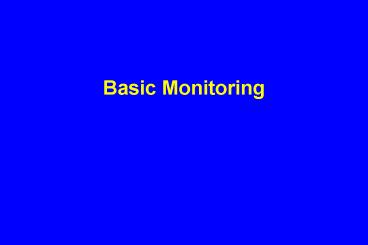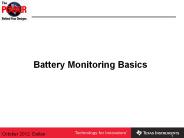Basic Monitoring - PowerPoint PPT Presentation
1 / 37
Title:
Basic Monitoring
Description:
All machines & equipment shall conform to national & state regulations ... The TRAM Monitor. Transport Remote Acquisition Monitor. Self contained unit. ECG ... – PowerPoint PPT presentation
Number of Views:57
Avg rating:3.0/5.0
Title: Basic Monitoring
1
- Basic Monitoring
2
Reasons to Monitor
- Patient safety
- Positive outcome
- Intra-operative case adjustments
- Assess equipment function
- Improve patient vigilance
3
Anesthesia Equipment
- Complete check daily
- Abbreviated check before each case
- All machines equipment shall conform to
national state regulations - Ongoing preventive maintenance program shall be
established and enforced
4
Monitors enable the early detection of mishaps.
Early detection enables early action to prevent
patient harm.
5
Patient Monitoring Standards(AANA Professional
Practice Manual)
- Direct observation
- Ventilation
- Oxygenation
- Circulation
6
Standard V (AANA Professional Practice Manual)
- The patients physiologic condition shall be
monitored consistent with type of anesthesia care
and specific patient needs.
7
Monitoring Standards
- Ventilations
- Body temperature
- Neuromuscular function
- Cardiovascular
- Anesthesia equipment
8
Observing the Patient
- General appearance
- skin color
- Level of consciousness
- anxious
- responsive
9
Monitoring Ventilation
- Chest auscultation
- Chest movement
- ETCO2-SAO2
- Spirometry/ventilatory pressure
- Ventilator disconnect Alarms
10
What do we want to know?
- Is the patient ventilating?
- Is the ventilation adequate?
- Is the tube properly placed?
- Is the ventilator functioning properly?
- Are there adverse responses?
11
Observing Ventilation
- Rate and depth
- Tracheal tug
- Paradoxical motion
- Loud breathing / snoring
12
Monitoring Oxygenation
- Pulse oximetry
- Observation of skin color
- ABGs when indicated
- Oxygen analyzer with alarm
- Oxygen supply failure alarm
13
Monitoring Circulation
- Blood pressure/pulse q/5 min
- Continuous ECG
- Auscultation of heart sounds
14
Circulation (Contd)
- At least 1 of the following
- continuous intra-arterial pressure monitoring
- electronic pulse monitoring
- pulse oximetry
15
The term finger on the pulse arose from the
tradition of vigilance by anesthetists.
16
The Precordial Detects
- Absence of breath sounds
- Wheezing
- Sudden appearance of murmur
- Irregular beats
- Absence of heart sounds
17
The use of the precordial / esophageal
stethoscope is standard of care at KU. We expect
you to use it on every case.
18
Urinary Output
19
Temperature
20
Neuromuscular Function
- The means to evaluate neuromuscular function
with a nerve stimulator when neuromuscular
blocking agents are used.
21
Monitoring frequency
- What is the maximum change allowed?
- What is the anticipated rate of change?
22
Frequency
- Common plan
- Frequently at start (2-3 min)
- Less often during maintenance phase (5 min)
- Note Some will need continuous monitoring
23
Types of Mishaps
- Hypoxic gas mixture
- Hypoventilation
- Circuit disconnect
- Esophageal/bronchial intubation
24
Types of Mishaps (Contd)
- Inhalation anesthetic overdose
- Hypovolemia
- Pneumothorax
- Air embolism
- Hyperthermia
25
Types of Mishaps (Contd)
- Aspiration
- Acid-base imbalance
- Arrhythmias
- IV drug overdose
26
The Anesthesia Machine
- (ASTM Section 16)
- Alarms classified by priority
- high
- medium
- low
27
Types of Machine Monitors
- Oxygen supply
- alarms with supply lt psig
- Fail safe valves
- Oxygen ratio alarm
- Oxygen analyzer
- Low pressure Alarm (disconnect monitor)
28
Anesthesia Machine (Contd)
- Distinguishable audibly and visually
- Require response according to priority
29
Observe your machine
- Flow rates
- Bellows movement
- Tidal volume
- CO2 canister
- Flutter valves
30
Machine Alarms
- Inspired oxygen
- High / low pressure alarms
- Minute ventilation
- Oxygen ratio alarm
31
Monitoring During Transport
32
Patients who require beat to beat monitoring in
ICU and during surgery deserve no less while
being transported
33
Injury to trauma patients may be increased if not
monitored en route from ER to OR via diagnostic
tests
34
Transport Considerations
- How ill is the patient?
- How stable is the patient?
- Where are you going?
- How will you get there?
- How long will the transport take?
- How much help will you have?
- What are your resources?
35
Parameters to Monitor
- Cardiovascular status
- ECG
- BP, CVP, PAOP
- Oxygenation
- Special monitors
36
Preparation is essential for safe transport
- Organize monitors and lines
- Make sure receiving end is ready
- Plan the most efficient route
- Have plenty of help
37
The TRAM Monitor
- Transport Remote Acquisition Monitor
- Self contained unit
- ECG
- BP, CVP, A-line, PAOP
- Pulse oximetry































